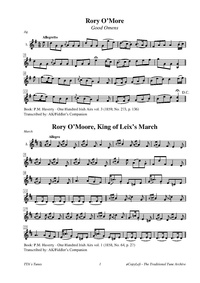Template:Pagina principale/Vetrina: Difference between revisions
No edit summary |
No edit summary |
||
| Line 9: | Line 9: | ||
|f_notes= Rory O'More from John Derrick's The Image of Irelande, with a Discoverie of Woodkarne. | |f_notes= Rory O'More from John Derrick's The Image of Irelande, with a Discoverie of Woodkarne. | ||
|f_caption=Despite the non-Irish provenance of the jig, “Rory O’More” was celebrated in the poem “The Ould Irish Jig,” by James McKowen (1814-1889):{{break}} | |f_caption=Despite the non-Irish provenance of the jig, “Rory O’More” was celebrated in the poem “The Ould Irish Jig,” by James McKowen (1814-1889):{{break}} | ||
An ould Irish jig, too, was danced by{{break}} | ''An ould Irish jig, too, was danced by''{{break}} | ||
The kings and the great men of yore,{{break}} | ''The kings and the great men of yore,''{{break}} | ||
King O’Toole could himself neatly foot it{{break}} | ''King O’Toole could himself neatly foot it''{{break}} | ||
To a tune they called “Rory O’More”. | ''To a tune they called “Rory O’More”''. | ||
|f_source=[https://soundcloud.com/fasterthanlime/rory-omore-saddle-the-pony-bioshock-infinite-cover Soundcloud] | |f_source=[https://soundcloud.com/fasterthanlime/rory-omore-saddle-the-pony-bioshock-infinite-cover Soundcloud] | ||
|f_pix=420 | |f_pix=420 | ||
Revision as of 13:36, 15 September 2023

An ould Irish jig, too, was danced by
The kings and the great men of yore,
King O’Toole could himself neatly foot it
To a tune they called “Rory O’More”.
Played by: Amos Wenger
Source: Soundcloud
Image: Rory O'More from John Derrick's The Image of Irelande, with a Discoverie of Woodkarne.

was a very popular tune from the late 1830's to the end of the 19th century, frequently published and a common entry in period musicians' manuscript collections.
Colonel Roger “Rory” O’More (c. 1620-1655) was a minor Irish noble and the titular King of Laois, who rose to fame as the scourge of the English during the reign of Charles I.
The jig was composed by Irish songwriter, novelist, composer and painter Samuel Lover [1] (1797-1868) and became the "hit tune" of 1837. Although initially a dance tune (a popular Scottish country dance is called "Rory O'More"), it was absorbed as a common march in the Victorian era British army and can be found in martial manuscript books dating from the 1850's (Winscott).
“Rory O’More” also appears in English fiddler’s manuscripts from the same era (see Ellis Knowles and Joshua Gibbons, referenced below).
The melody was picked up by morris dancers from the village of Adderbury, Oxfordshire, in England's Cotswolds and used as a rural dance vehicle sometimes called by morris musicians as “Haste to the Wedding” and played in the key of ‘F’.
...more at: Rory O'More - full Score(s) and Annotations
X:1 T:Rory O'More T:Good Omens M:6/8 L:1/8 Q:"Allegretto" R:Jig B:P.M. Haverty – One Hundred Irish Airs vol. 3 (1859, No. 273, p. 136) Z:AK/Fiddler’s Companion K:G e|dGG {B}AGG|dGG (Gge)|(d>cB) (B>AG)|FAA A2 (B/c/)| dGG {B}AGG|DGG !fermata!e2 (d/c/)|(B>cd) def|gGG [B,2G2]|| g|(g>fe) eBB|{d}(cBA) G2F|(E>FG) (GAB)|(Bed) d2 (e/f/)| (g>fe) eBB|{d}(cBA) G2F|(E>FG) (GAB)|(Bed) !fermata![F2d2]!D.C.!||
